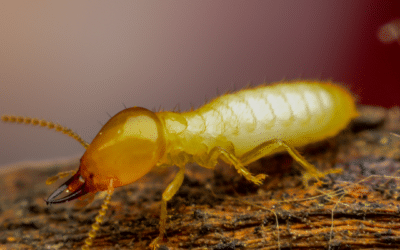What are Winged Termites?
Winged termites are just that, airborne termites. These species are just as destructive as typical termites with the only difference being their ability to fly. So, why do these pests have wings? Well, only a certain caste of termites have wings, and they’re called “alates” (often referred to as “swarmers”). In some instances, regular termites can have wings in their reproductive stages. However, alates are the only type of termite to have wings their entire lifespan.
Not to be confused with flying ants.
A major point in discussing winged termites is their similarity to flying ants. Many people easily get these two airborne pests confused, but they are incredibly different. Flying ants look different. Flying ants have an hourglass-shaped body that comes in at the waist, and winged termites do not. The termites have a broad body from head to toe and maintain this broadness at the waist.
The shape of their wings is entirely different. Both species have a set of forewings and hind wings. However, flying ants’ forewings are larger than their hind wings, while winged termites’ wings are both the same size. Lastly, their antennae shape differs. Flying ants have an elbow-shaped antennae with a hard 90° angle, whereas winged termites have beaded antennae. Now that we’ve cleared up the confusion, let’s hop right into the habits of winged termites.
Do I have a winged termite issue?
Identifying the problem at hand is the first step in pest control. When it is not obvious, the easiest way to identify which pest has invaded your home is by looking at three criteria:
- How did these pests enter your home?
- What have they done to your home?
- How did they affect you, your family, or your pets?
Let’s outline each of the following criteria in terms of winged termites and discuss how to rid yourself of these pests.
How did winged termites get into your home?
Typically, they either get stuck in your home unintentionally or fly in through cracks in your foundation. In some instances, winged termites want to be in your house as much as you want them to be there. These pests simply fly around all day and could’ve flown right into your home unintentionally. They could’ve come through an open window or door and are simply looking for a way out. Winged termites, like most tiny critters, are attracted to light. So, if you have bright lights on your front porch or in your attic, you could be attracting these pests.
What do winged termites leave in their wake?
In many cases your home is not habitable for winged termites, meaning they cannot flourish in your home. They’ll likely suffer from a lack of outside nutrients. These pests will probably begin to wither and die, leaving their bodies or their wings behind. If you find small sets of wings around your home, minus the body, then you are likely dealing with winged termites. Furthermore, winged termites leave typical termite damage around your home. They’ll feast on your wood framing, baseboards, and even the banister of your stairs. Pretty much anything winged termites can get their hands on becomes food. So, if you have discovered damage of that nature, then you likely have a winged termite issue.
How do winged termites affect humans and pets?
This aspect is actually not an issue for us humans at all. They are not known to carry diseases that make humans ill. These pests are not known to bite, sting, or swarm humans. These termites seem to be somewhat introverted and want as much to do with you as you want with them. These pests want a comfy chateau, and they don’t get hostile when they have to share with humans. In that aspect, it is great because they don’t cause you or your family harm. However, it’s not so great in that these critters won’t have any reason to leave your home other than a food shortage. So, how do you get rid of them?
How do I protect myself from winged termites?
The easiest way to protect you and your family from these termites is by being on high alert. As we mentioned above, these termites typically enter your home through open windows or foundation cracks. The easiest way to keep them from coming in is by closing all available entry points. So, seal off any foundation cracks and ensure you have screens on your windows. Additionally, look along your roofline and near any doors to ensure that all points of entry are sealed. You are absolving yourself of any future trouble by simply checking to ensure your home is sealed tight.
What do I do now?
So, what if you already have a winged termite issue? Well, the answer is simple: Schedule a FREE Inspection with 855Bugs and let us take care of it for you! We want you to be happy and healthy, and living with little critters isn’t what we’d recommend! Call us or schedule an inspection online today!




